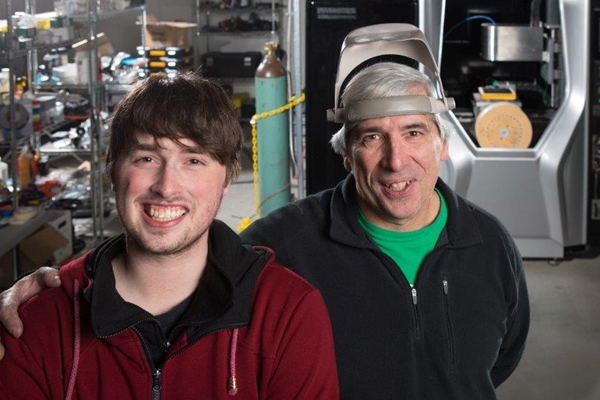13 January 2017. A spin-off enterprise from University at Buffalo engineering school developed a machine that produces lower-cost aluminum parts with three-dimensional liquid metal printing. The father-and-son team of Scott and Zachary Vader founded Vader Systems in 2013, with its facilities now in nearby Getzville, New York.
Zack Vader got the idea of 3-D printing parts from metal in liquid form while an undergraduate student in engineering at Buffalo. Current 3-D printing with metal uses a sintering process that requires firing laser or electron beans at metal in powdered form. While sintering can produce complex printed parts, the Vaders say any powder not melted can result in weak spots in the part. Current processes are also slow, with adding more laser-fired printing elements needed to speed up production.
The Vader process, called magnetojet, makes metal parts with a process more resembling ink-jet printing. Magnetojet uses commodity aluminum wire fed into a ceramic chamber, where the metal is heated and liquefied at 750 degrees Celsius (1,382 degrees Fahrenheit). The molten aluminum is then electromagnetically pulsed into micro-scale droplets. Vader’s current MK1 system delivers 1,000 droplets per second, ranging in size from 200 to 500 microns, where 1 micron equals 1 millionth of a meter. The company says the MK1 is twice as fast as 3-D printing with powdered metal, producing parts at 90 percent of the cost.
Vader Systems joined the Start-Up NY entrepreneurial incubation program in 2014, which gives the company access to technical resources from University at Buffalo and 10 years without paying state or local taxes. The university provides faculty advisers as well as student interns. Vader Systems already hired 3 graduates from Buffalo’s engineering school.
One of the Vader’s faculty advisers is Chi Zhou, an industrial systems engineering professor, who helped write open-source software for controlling the printer. “I can see at this stage that it can complement traditional metal printing,” says Zhou in a university statement, “but later, maybe 10 years later, it can dominate the metal printing market because it can print better quality, cheaper, and faster.”
The Vaders — father Scott is CEO, while son Zack is chief technologist and his mother Pat Roche is company comptroller — raised $1.35 million in seed capital over the past 2 years, including $750,000 in June 2016. At the time, Scott Vader told a Buffalo business newspaper that Vader Systems has “20 strong leads on our first machine,” and expected to close some sales in the next 3 months. One of those sales was to Rochester Institute of Technology for its additive manufacturing center.
The strong expected sales growth already has Vader Systems looking for a larger production facility. In the meantime, Vader Systems is working on a second-generation machine that can print steel, requiring the melting of steel wire at 1,400 C and adding more nozzles for faster printing of complex parts. Zack Vader notes that its systems can make complex parts as inexpensively as simple items, which will appeal to automotive manufacturers, among others.
The following video tells more about Vader Systems and its 3-D printing process.
- Solar Reactor Devised for Small-Scale Chemical Production
- Ordinary Smartphones Able to Hack 3-D Printers
- Computer Models to Boost 3-D Print Designs in Mfring
- Report from Maker Faire: Plastic Recycling Made in Space
- Univ. of Pittsburgh, Ansys Partner on Additive Mfring
* * *


 RSS - Posts
RSS - Posts
You must be logged in to post a comment.